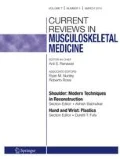Abstract
Today’s most basic and important total knee replacement design concepts arose out of an earlier era in which 2 distinct approaches emerged, functional and anatomic. Functional approaches simplified knee kinetics, were easier to implant, and gained widespread popularity, in part, from their inventory control. Anatomic approaches were an attempt to recreate normal knee motion with low prosthetic contact stress. Historically, however, they became impractical to produce because of the cost of maintaining a wide variety of anatomic knee implants. New customized designs may return the anatomic design to favor due to several key features that borrow anatomic principles developed in the past, and improved with new ideas.


Similar content being viewed by others
References
Papers of particular interest, published recently, have been highlighted as: • of importance
Ranawat CS, Shine JJ. Duo-condylar total knee arthroplasty. Clin Orthop Relat Res. 1973;185–95.
Walker PS, Wang C-J, Masse Y. Joint laxity as a criterion for the design of condylar knee prostheses. Proc Inst Mech Eng. 1974;CP16:22.
Walker PS, Ranawat C, Insall J. Fixation of the tibial components of condylar replacement knee prostheses. J Biomech. 1976;9:269–75.
• Robinson RP. The early innovators of today's resurfacing condylar knees. J Arthroplasty. 2005;20(1 Suppl 1):2–26. Best summary of early history in total knee replacement and provides a good overview about difference between anatomic and functional knee designs.
Murray DG JHS, Inventor. Knee joint prosthesis. US patent 4,016,606. April 12, 1977, 1977.
Goodfellow JW JJS, Nigel G. Inventor. Prosthetic joint device. US patent 4,085,466. April 25, 1978. 1978.
Yamamoto S. Total knee replacement with the Kodama-Yamamoto knee prosthesis. Clin Orthop Relat Res. 1979;145:60–7.
Townley CO. Total knee arthroplasty, a personal retrospective and prospective review. Clin Orthop. 1988;236:8.
Townley CO. The anatomic total knee resurfacing arthroplasty. Clin Orthop Relat Res. 1985;192:82–96.
Mallory TH, Smalley D, Danyi J. Townley anatomic total knee arthroplasty using total tibial component with cruciate release. Clin Orthop Relat Res. 1982;169:197–201.
Ewald FC Inventor. Joint Protheses. US patent 3,798,6791971.
Waugh TR, Smith RC, Orofino CF, Anzel SM. Total knee replacement: operative technical and preliminary results. Clin Orthop Relat Res. 1973;94:196–201.
Mahoney OM, Kinsey T. Overhang of the femoral component in total knee arthroplasty: risk factors and clinical consequences. J Bone Joint Surg Am. 2010;92:1115–21.
Sell D. Legal tussle in market for medical devices. The Inquirer. April 5, 2012. 2012.
Kadoya Y, Kobayashi A, Komatsu T, Nakagawa S, Yamano Y. Effects of posterior cruciate ligament resection on the tibiofemoral joint gap. Clin Orthop Relat Res. 2001;391:210–7.
Fitz W, Sodha S, Reichmann W, Minas T. Does a modified gap-balancing technique result in medial-pivot knee kinematics in cruciate-retaining total knee arthroplasty? a pilot study. Clin Orthop Relat Res. 2012;470:91–8.
Howell SM, Kuznik K, Hull ML, Siston RA. Results of an initial experience with custom-fit positioning total knee arthroplasty in a series of 48 patients. Orthopedics. 2008;31:857–63.
Fishkin Z, Miller D, Ritter C, Ziv I. Changes in human knee ligament stiffness secondary to osteoarthritis. J Orthop Res. 2002;20:204–7.
• Hunter DJ, Niu J, Felson DT, Harvey WF, Gross KD, McCree P, et al. Knee alignment does not predict incident osteoarthritis: the Framingham osteoarthritis study. Arthritis Rheum. 2007;56:1212–8. Describes the distal femoral condylar angle, which explains why symmetric off-the-shelf knee designs don't fit. Also describes the tibial varus angle to justify an asymmetric higher lateral insert which cannot be achieved using symmetric off-the-shelf knee designs.
• Cobb JP, Dixon H, Dandachli W, Iranpour F. The anatomical tibial axis: reliable rotational orientation in knee replacement. J Bone Joint Surg Br. 2008;90(8):1032–8. Describes the center of medial and lateral tibial plateau which is the method the tibia tray is designed given the high variability of the medial tibial tubercle.
• Lawrie CM, Noble PC, Ismaily SK, Stal D, Incavo SJ. The flexion-extension axis of the knee and its relationship to the rotational orientation of the tibial plateau. J Arthroplast. 2011;26(6 Suppl)):53–8. Explains why surgeons should be careful using the tibial tubercle for tibial component rotation.
Bedard M, Vince KG, Redfern J, Collen SR. Internal rotation of the tibial component is frequent in stiff total knee arthroplasty. Clin Orthop Relat Res. 2011;469:2346–55.
Nicoll D, Rowley DI. Internal rotational error of the tibial component is a major cause of pain after total knee replacement. J Bone Joint Surg Br. 2010;92:1238–44.
Fang DM, Ritter MA, Davis KE. Coronal alignment in total knee arthroplasty: just how important is it? J Arthroplast. 2009;24(6 Suppl):39–43.
Berend ME, Ritter MA, Meding JB, Faris PM, Keating EM, Redelman R, et al. Tibial component failure mechanisms in total knee arthroplasty. Clin Orthop Relat Res. 2004;428:26–34.
Slamin J, Ketelhon, R. Bojarski, R., Parsley, B. Optimizing Knee Femoral Component Strength and Bone Preservation with Finite Element Analysis. Proceedings of the Orthopaedic Research Society; 02/042012–02/07/2012, 2012; San Francisco, CA.
Disclosure
EM Schwechter: none; W. Fitz: Member of scientific advisory board, consultancy, patents, stock/stock options, and receives royalties from Conformis, Inc.
Author information
Authors and Affiliations
Corresponding author
Rights and permissions
About this article
Cite this article
Schwechter, E.M., Fitz, W. Design rationale for customized TKA: a new idea or revisiting the past?. Curr Rev Musculoskelet Med 5, 303–308 (2012). https://doi.org/10.1007/s12178-012-9143-x
Published:
Issue Date:
DOI: https://doi.org/10.1007/s12178-012-9143-x




